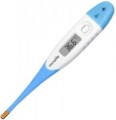Measurement duration
The time it takes for a thermometer to provide a temperature reading, from contact or activating the IR sensor to obtaining the result, is crucial for efficiency. Quick measurements save time during temperature checks. However, it's important to mention that for axillary use (see "Application area"), it's advised to keep the thermometer in place for a minimum of 5 minutes, irrespective of the manufacturer's specified measurement time, due to the nature of the procedure.
Measurement range
The range of temperatures that a thermometer can measure.
For measuring body temperature, a range of 35 – 43 °C is considered ample, covering values encountered in individuals with high fever or hypothermia. Although modern medical thermometers may have broader ranges, especially those designed for water and air temperature measurement (e.g., -20 – 100 °C), when used for body temperature, they typically operate within a narrower range. The overall and "solid" measurement ranges are often specified separately in these thermometers.
Measurement accuracy
The extent to which a device deviates from the actual temperature during measurements determines its accuracy. Even the least accurate electronic medical thermometers today have a maximum deviation of 0.3 °C, sufficient for everyday and basic medical use. Common models offer even higher accuracy, with deviations as low as
0.1 °C or
0.2 °C, making the pursuit of maximum accuracy necessary only in specific scenarios.
Reading memory
The number of results the thermometer can store in memory. The ability to
"remember" the results of previous measurements can be very convenient in some cases — in particular, it allows you to accurately track changes in temperature over time. The most advanced models are capable of storing several dozen readings in memory.
Sound signal
The presence of a
sound signal in the thermometer. Most often, such a signal indicates the end of the measurement, which eliminates the need to independently monitor the time or get a device to check the readings. However, other events can also be accompanied by sounds, such as switching on and off.
Display backlight
Availability of
backlight at own display of the thermometer. This feature allows you to easily see the screen readings in low light and even in complete darkness.
Case included
The presence of a
case, mostly plastic to avoid damage to the device during storage or transportation.
Power source
Type of batteries used in thermometers.
— AA. The ubiquitous battery, commonly found everywhere batteries are sold, operates at 1.5 volts, making it widely accessible.
— AAA. The batteries, which are a compact alternative to AA batteries with the same 1.5V voltage, are widely used and suitable for small devices.
— CR2032. One of the most popular types of batteries, with a diameter of 20 mm and a thickness of 3.2 mm. Actual for use in compact devices.
